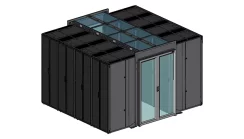How to Apply Monitoring Protection Levels in Critical IT Environments
We are often asked how best to protect a server room or data centre in terms of environmental monitoring. Our recommended approach to the environmental monitoring of a critical IT environments is to consider the protection level required and then to work through the number of sensors, base units and notifications required. Following this process helps our projects tema to define the specific monitoring solution required from the wide range of base untis, sensors and software packages we supply.
What is the Ideal Server Room Temperature and Humidity Level?
Selecting the optimum temperature for a server room is always a balance between looking to provide the best server room temperature and the electricity/energy usage required to power the room-based air conditioners to achieve this. Every 1°C of cooling costs and the lower the room temperature the higher the costs, depending on the cost per kWh of the electricity used.
IT servers, storage and network devices should never be run at the high end of their operating temperature range. A typical Dell EMC PowerEdge server can run in environments from 10°C to 35°C but the most efficient would be around 20°C. This also provides a more comfortable ambient for anyone working with the server room, data hall or data centre.
Our projects team recommends an optimal server room temperature range of 18-27°C and ideally 18-25°C. It is also important to consider humidity and we recommend a relative humidity of 40-60%.
Monitoring Protection Levels
The concept of server room protection levels can be applied to many other critical environments. The table below lists the protection levels we consider when discussing a monitoring project with a client.
| Level | Monitoring Conditions | Sensor Types |
|---|---|---|
| 1 | Temperature and Humidity | Temperarture, Temperature & Humidity |
| 2 | Water Leakage | Spot Water Location, Rope Water Leakage Detection |
| 3 | Air Conditioning Systems | Air flow, Spot Water Location (in drip trays) |
| 4 | Room Security | Door Contacts, Motion Detection, Sirens and Strobes, Smoke Detectors, IP Cameras |
| 5 | Power | AC Power Supply, DC Power Supply, Battery Health (voltage, current, temperature), Generator Fuel Level |
| 6 | Server Cabinet Thermal Maps | 6-point Temperarture, Temperature & Humidity, Temperature & Humidity & Differential Air Pressure) |
| 7 | Room Air Flow Modelling (CFD) | Software-based using data from Level 6 sensors |
From the table we define the environmental factors to be considered and the number of sensors required and how they should be installed. Most sensors are supplied with a cable length (1-3m) that connects them back to the environmental monitoring base unit. For longer cable lengths either the sensor will make use of easily available CAT5/CAT6 Ethernet cable or the sensor must be oredered with a specific cable lenght from the supplier.
See the full list ACKP sensors available grouped by Protection Level.
Base Units and Bundles
A base unit is the main data logging and processing unit. This is generally installed inside the server cabinet or top of a server rack. There are a variety of ways to install base units, dependent upon their design. The installation formats include 19inch rackmount (either the front or rear rack pillars) such as the AKCP sensorProbe+ SPX8, DIN-rail, placed on a shelf inside the server rack, wall mounted or magnetic.
The number of sensors required helps to determine the specific base unit required. Most environmental monitoring equipment manufacturers supply a range of base units, with each model having from one to two, four, eight and even 16 RJ45 ports, digital inputs (DI), digital output (DO). The use of a 1-WIRE UNI bus allows multiple sensors to be connected to the same RJ45 port. For example, a 2port RJ45 port using a 1-WIRE UNI Bus can connect to 15 physical sensors.
Some manufacturers also offer virtual sensors allowing the user to consider a virtual sensor port to monitor and log data from say an electricity meter or air conditioner via the MODBUS protocol.
For more information on the differences between MODBUS TPC and RTU watch:
https://www.youtube.com/watch?v=z-1octSsSBs
Once the number of sensor and base units have been identified the next step is to determine the monitoring software to be used.
Environmental Monitoring Software
There are two approaches to the monitoring software provide by equipment manufacturers.
The more traditional has been local LAN-based. The end use client downloads a software program from the manufacturer’s website and runs this on their local network. A typical example is the AKCPRO Server software. The software is licensed and available for free use for a set number of base units to monitor and allows a dashboard to be created from which to monitor the data, both live and historical. Additional licenses can be added to bring in compatible IP network camera feeds.
Cloud-based monitoring software is also available as an option from most manufacturers this may be provided free for the first year with subscriptions required for following years. These costs should be borne in mind when costing the overall project for say 5years and discounted price may be available for an extended period monitoring plan. The software may be ‘free for life’ but with less functionality than a fully subscribed version of the portal.
Some manufacturers offer mobile phone Apps. There is an argument that Apps only provide limited functionality. As most smart phones and tablets run HTML5 browsers, the monitoring software is best accessed directly to get access to the data, functionality and alerts.
Notifications and Alerts Required
A critical factor to consider for any environmental monitoring project is how to report the data and issue notification alerts. Environmental monitoring units act as data loggers, performing a data acquisition (DAQ) role and the data over a defined time period can be used several purposes including alert triggering, problem analysis, site records, and compliance reporting (for example in the food processing and chemicals industries).
Notifications are the alarm messages that will be triggered when data goes outside of a preset threshold range. Alarm messages can include email alerts, SMS text messages, phone calls. Information and alerts may also be communicated via protocols including SNMPv3.
In addition to defining the alert methodology, it is also important to consider the distribution list and to maintain this. For example, general notification alerts may be sent via email with alerts for important monitoring factors sent via email and SMS. Most IT managers for example prefer an SMS text due to the high number of emails they get.
Alternatives to Fixed Ethernet LAN Connections
A growing number of installations are looking at using wireless connections via the local WiFi for remote monitoring and report. Wireless allows for a faster and lower cost roll out of sensors and monitoring untis within both IT environments (server rooms and data centres) and other applications including large buildings and warehouses. Alternatives to WiFi connections include LoRA and Narrowband devices.
Configuration, Calibration and Installation Services
Our projects team provides a complete setup and installation service. We carry out site installations but also warehouse system setups before supply to site. This can help installers who may not be as familiar with the units and functionality.
For example, our projects team configures AKCP SP2+PRO units with internal modems in our warehouse (on a site-by-site basis) before rolling out to specific locations for a nation-wide project. On-site the client uses a third-party installations team. The config also includes the setting up of daily heartbeat messages; the devices send a health status SMS text at 8am daily to defined mobile numbers. With some units, daily email watchdog type alerts are also possible.
Another service offered under our maintenance plans is sensor calibration testing. This can be important for manufacturing plants using multiple sensors throughout and requiring an annual calibration certificate.
Summary
Environmental monitoring units collect data on a 24/7 basis and will continue to report this provided there is a connection to the monitoring software deployed. Heartbeat messages and Watchdogs provide a way to monitor for disconnection, but nothing beats a ‘black run’, and we recommend this at least once a year. For example, temperature and humidity sensors can be warmed to their trigger levels and the notifications list checked to ensure all recipients received their defined alert(s).
Environmental monitoring in data centres is a given but there are thousands of server rooms that do not have any monitoring in place. These are the sites that quickly suffer when an air conditioner fails and the site experiences downtime. With monitoring solutions priced from under £200 per unit with a temperature monitoring sensor, the investment required for peace of mind is minimal, even for a level 1 monitoring configuration.


























